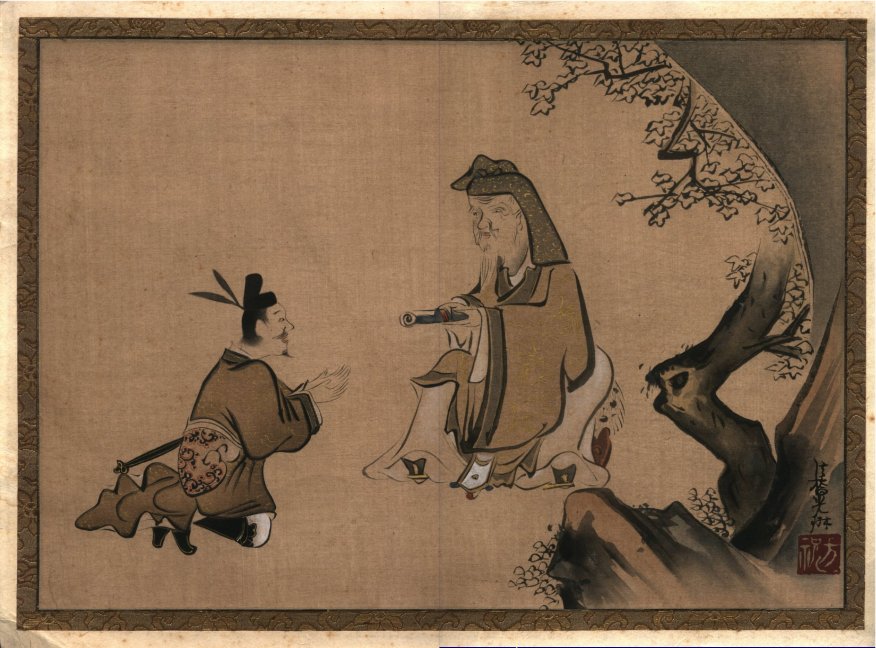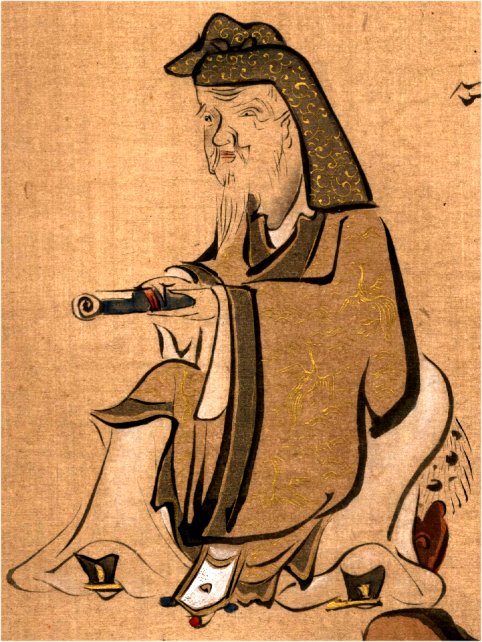





Japanese Figure Painting by Japanese Rimpa Master Ogata Korin (1658-1716)
日本琳派宗師尾形光琳(1658一1716)人物畫
Korin 光琳 (1658-1716)
N. Ogata Koretomi 尾形惟富 F. N. Kariganeya Tojuro 雁金屋藤重郎 Katsuroku 勝六 Go. Hoshuku 方祝 Korin 光琳 Jakumei 寂明 Dosu 道崇 Kansei 澗聲 Iryo伊亮 Seiseido 青之堂 Chokoken 長江軒 S. Distinguished painter. Founder of Korin school. Studied under Yamamoto Soken when young. Influenced by Sotatsu and Koetsu. But later founded his original style. L. & C. Born in Kyoto and lived in Edo. Excelled in calligraphy, painting and the technique of makiye 蒔繪. And also good at making ink-stone boxes and tea things. Was nominated to Hokkyo. Sp. flowers-and-birds (rather decorative).
Korin-zuroku 光琳圖錄 Ogata Korin 尾方光琳
Ogata Korin (1658-1716)
Japanese decorator and painter. He is renowned for his lacquer work and paintings on screens, decorated with bold designs and striking color contrasts, and his masterful compositional use of empty space. These works show the influence of two earlier artists, Koetsu and Sotatsu, but he departed from conventions, creating his own nearly abstract style. He also excelled as a teacher.
Korin's signature, on the lower right corner, contains the honorary title "hokkyo," granted him by the court in 1701 and included in almost all of his major paintings. The calligraphic style of the signature and the square seal, reading "Hoshuku" indicate that the painting must have been created during the last few years of the artist's life. From about 1704 Korin began commuting between Kyoto and Edo, where he hoped to find affluent patrons. Disappointed by a lack of success in the younger city, he returned home early in 1709; in 1711 he settled down and built a new house in Kyoto. This painting is thought to date to this period.
尾形光琳(1658一1716)
是京都的“雁金屋”富商服裝店主尾形宗謙的次子,本稱他為市之丞,到三十四歲時才改名光琳。雁金屋是豐臣秀忠之女和子御用的名店。本阿彌光悅是光琳祖父宗伯的母方叔叔,家學淵源,他的父親宗謙是一位多才多藝而且有多方面興趣的人,對能樂、茶道、繪畫、書法都喜愛,具備這麼多樣的藝能,加上做服裝這種家業,容易結交公卿達官與諸大名等上層杜會人士,光琳和他的弟弟乾山兩人便是在這樣富裕的家庭,和多才多藝的父親這種優越的環境下長大。光琳從小就具有很優秀的天分,學習能樂、書法、繪畫,十五歲的時候,就與父兄經常上台表演能樂。繪畫方面,初步的階段是和他父親學的,後來進入當時京都狩野所屬的本素軒門下,學習狩野派的運筆法,再進一步研究土佐畫風,學習土佐畫風的彩色法。父親死後,他和弟弟繼承了父親遺留給他們很多的財產。但由於其中很多都是借給大名(萬石以上的諸侯)的借票據,大部分都收不回來,加以他們為人慷慨而且浪費無度,40歲時他將父親的遺產蕩盡,而陷於窮困潦倒境地。至此,他才開始認真反省以前的藝術遊戲,自覺本身有才能天分,便立志成為畫家,開啟他的獨特道路。他的藝術活動得到一些親友的贊助,1701年獲得法橋地位(宮庭畫家封號),成為知名畫家,但生活似乎仍不安定。1704年,他去江戶(即東京),受到富商冬木家、大名津輕家和酒井家的庇護。但他不願受大名的束縳,1709年毅然返回京都,死時清貧如洗。
那時正是元祿時代,百姓都做著太平的夢,市井文化出發達。光琳在藝術方面決定走出和桃山藝術不同的方向,以豪華的裝飾繪畫,構成光琳畫風的主要因素首先是狩野派手法。光琳最初從京狩野系統的山本素軒學畫,晚年去江戶時又從江戶狩野攝取營養。《維摩圖》(反町家)等作品,就具有狩野派特性,其中又可窺見與英一蝶相通的輕妙洒脫的風姿。第二,不可忽視他將家傳的衣服紋樣及其構成法轉用于繪畫。最有代表性的例証是《紅白梅圖》屏風中出現的抽象水波紋,它以后被稱為“光琳波”而普遍流行。第三,也應注意到他對于寫生的重視,如《鳥獸寫生帖》(組田家) 所見。但是,最終決定他畫風的因素,還是在于對宗達畫風的攝取。比如《草花圖卷》 (中村家,1705)、《風神雷神圖》屏風 (東京國立博物館) 就是模仿宗達的作品而成。然而,光琳藝術的意義,絕不是停留于簡單繼承宗達畫風上,而是通過自身的惑覺和構成原理,建立更嚴格的造型秩序。《燕子花圖》屏風(根津美術館) 和《紅白梅圖》屏風 (熱海美術館),就是體現這種追求的代表作,也是他全部作品中最為有名的兩件傑作。《燕子花圖》表現得開放、明多快,予人非常舒暢的感覺。相反地,《紅白梅圖》則在構圖中讓左右對立而又充滿著緊張感的作法,今人感到完全不同的感受。宗達與光琳的差別,在於宗達是經常保持輕鬆的和畫的對象融於一體,把他本人融在圖畫中,而光琳則一方面注重所描繪對象的客觀性,另一方面又要在寫實中講求造型效果,因此在構圖上費盡心思。
光琳也制作蒔繪,又為其弟尾形乾山的陶器作畫,還擅長染織圖繪,留有白地秋草紋小袖(東京國立博物館)的作品。
Edo era - A period in Japanese art history from 1615 to 1868. Edo is the original name for Tokyo. The period began when the warlord Tokugawa Ieyasu took control of Japan, established his shogunate capital and started shaping the country to his will. He shut the door to the outside world and kept his daimyo underlords on a tight leash, requiring them to reside in Edo every other year, where he held their wives and children as hostages. The rigid structure of Edo society was based on imported neo-Confucian values, with the military elite and salt-of-the-earth farmers at the top and middleman merchants below. A code of nit-picking sumptuary laws dictated who could own and wear what. Among the upper classes, competitive extravagance was as much a social responsibility as a privilege, and it produced an extraordinary art.
Japanese art of this period includes painted screens, samurai swords, ceramics, theater costume, Buddhist sculptures, woodcuts, and much more.
The Edo period was preceded by the Momoyama period (1490-1573).
The late Edo period was an urban moment; Tokyo in the 18th century was the largest city in the world. Class barriers were fluid; money was new, loose, plentiful. Downtime became a preoccupation, leisure an industry.
Click Here to See Other Japanese Paintings
Click Here to See Other Paintings
Click Here to Go Back to Homepage